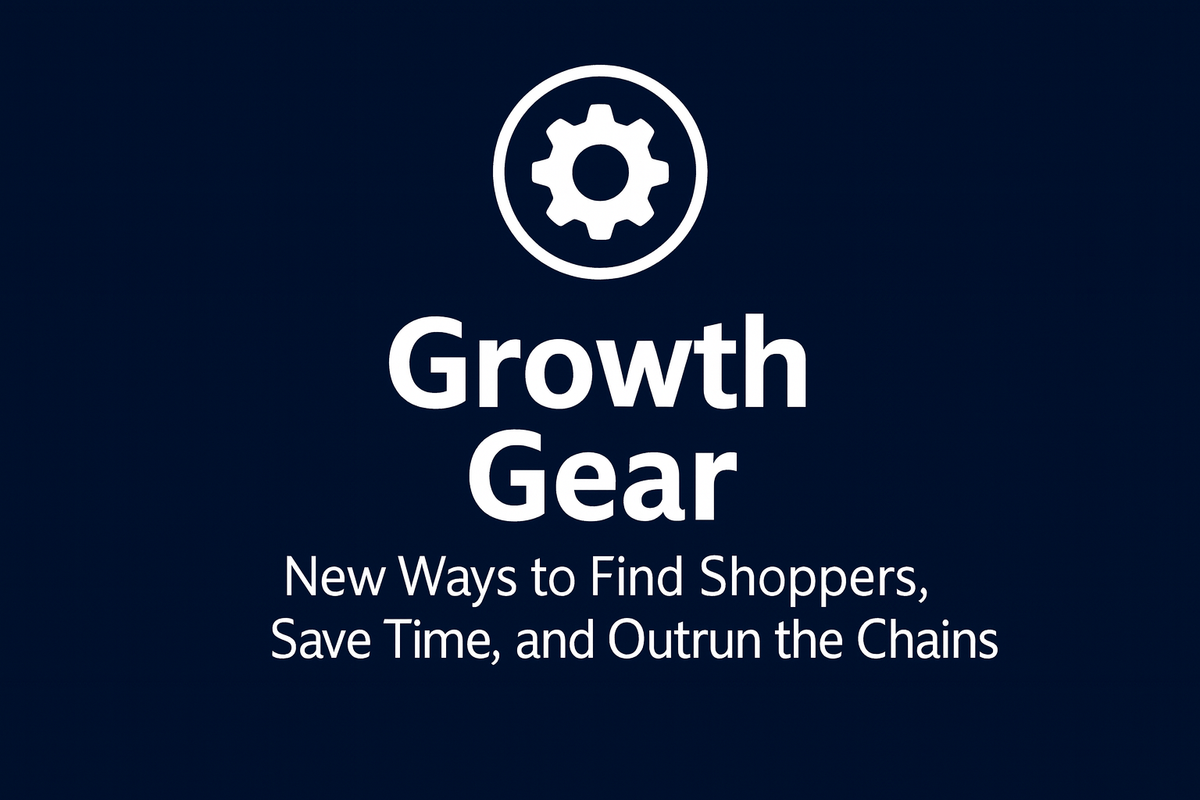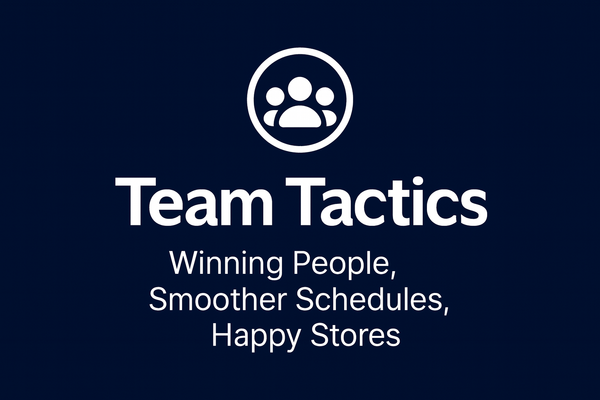Peak Performance: How Strategic Systems Turn Rush Hour Chaos into Profit Opportunities
Busy hours expose every flaw—or every strength. Learn how to systematize peak traffic management with proven methods that boost revenue, reduce stress, and turn your store’s busiest moments into its biggest profit opportunities.

Stores with systematic peak traffic management achieve 25% higher revenue per customer during rush periods and 40% better customer satisfaction scores, according to retail operations research from DTI, yet most convenience store operators react to busy times rather than strategically managing them. With nearly 50% of all convenience store traffic occurring during just three peak periods—morning commute (6:30-9:00 AM), lunch rush (11:30 AM-1:30 PM), and evening return (5:30-7:30 PM)—according to NPD Group data, the difference between systematic preparation and reactive chaos can mean thousands of dollars in daily revenue variance.
The stark reality is that peak periods reveal every operational weakness while offering the greatest profit opportunities. While competitors scramble to manage lines and frustrated customers during busy times, winning operators transform these critical moments into competitive advantages through systematic workflow optimization, strategic staffing models, and technology integration that turns potential chaos into profitable efficiency.
Beyond "All Hands on Deck": Strategic Peak Traffic Management Defined
Strategic peak traffic management extends far beyond basic staffing increases to encompass systematic workflow optimization, predictive planning, strategic product placement, and technology integration that creates sustainable competitive advantages. Unlike reactive "all hands on deck" approaches that often create more chaos than efficiency, strategic management involves systematic preparation that begins before customers arrive and continues through systematic post-peak analysis, according to retail operations research from Queue Solutions.
The fundamental distinction lies between managing the crisis versus preventing it through preparation. Traditional approaches focus on responding to long lines and frustrated customers after problems develop, while strategic management creates systems that handle peak volumes smoothly by anticipating demand patterns, optimizing workflows, and positioning resources proactively.
Modern peak traffic management integrates multiple operational systems working in concert rather than relying on individual heroic efforts. According to convenience store operations research from C-Store POS, successful peak management combines traffic pattern analysis, strategic staffing models based on data rather than intuition, workflow optimization that enables efficient multitasking, and strategic product positioning that accelerates transactions while increasing average basket size.
The systematic approach recognizes that peak periods follow predictable patterns that enable proactive optimization. Rather than treating busy times as random events requiring emergency response, strategic operators analyze historical data to identify specific traffic patterns, transaction types, and operational bottlenecks that can be addressed through systematic preparation and process improvement.
Technology integration becomes essential for scaling human capabilities during peak periods. Modern POS systems, queue management technology, and workflow optimization tools enable small teams to handle volumes that would overwhelm unprepared operations, transforming peak periods from operational nightmares into systematic profit generation opportunities.
Key Operational Systems for Peak Excellence
Traffic Pattern Analysis and Predictive Planning
Effective peak management begins with understanding exactly when, how, and why traffic increases occur at specific locations. Rather than relying on general industry assumptions about busy times, successful operators analyze their specific traffic patterns to identify unique characteristics that inform staffing, inventory, and operational decisions, according to retail analytics research from HNS Energy Group.
The analysis extends beyond simple sales volume to examine transaction composition, customer behavior patterns, and operational stress points that affect service quality. Morning coffee rush customers have different needs and expectations than evening snack buyers, requiring different product positioning, staffing skills, and service approaches that optimize both speed and satisfaction.
Predictive planning involves preparing for traffic build-up rather than just peak transaction volumes. Industry research shows that customer arrival patterns often precede sales spikes by 15-30 minutes, creating opportunities for proactive preparation that prevents bottlenecks before they develop rather than reacting to problems after lines form.
Strategic Staffing Models Based on Data and Capability
Effective peak staffing goes beyond adding more people to include strategic role assignments, cross-training for flexibility, and capability-based scheduling that maximizes team efficiency during critical periods. According to workforce management research from Legion, convenience stores achieve optimal peak performance when staffing decisions consider individual capabilities, task complexity, and workflow integration rather than simply increasing headcount.
The staffing model should account for the reality that not all employees perform equally well under pressure. Peak periods require staff members who can multitask effectively, maintain accuracy under pressure, and provide friendly service when customers are hurried or stressed, making strategic assignments more important than total staffing levels.
Cross-training enables flexible role assignments that adapt to changing conditions during peak periods. When morning coffee equipment requires attention or unexpected deliveries arrive during busy times, cross-trained staff can shift responsibilities without compromising service quality or creating operational bottlenecks.
Workflow Optimization for Multi-Tasking Efficiency
Peak period workflow optimization focuses on eliminating unnecessary movements, reducing task switching, and creating smooth handoffs between different operational responsibilities. Research from retail operations specialists shows that optimized workflows can increase peak period efficiency by 30-40% without requiring additional staffing, according to Isarsoft customer flow analysis.
The optimization process involves mapping current workflows during peak periods to identify time wasters, bottlenecks, and opportunities for streamlining. Simple changes like strategic product placement, pre-positioned supplies, or modified checkout procedures often generate significant efficiency improvements without requiring technology investments or major operational changes.
Multi-tasking strategies must balance efficiency with accuracy to avoid creating new problems while solving existing ones. Effective peak workflows enable staff to handle multiple responsibilities while maintaining service quality and operational standards that protect both customer satisfaction and business profitability.
Strategic Product Positioning and Peak-Optimized Merchandising
Strategic product placement during peak periods can significantly impact both transaction speed and average basket size by positioning impulse items, grab-and-go options, and complementary products where customers naturally encounter them during busy periods. According to convenience store merchandising research, strategic peak-period product positioning can increase average transaction size by 15-20% while reducing checkout time, notes retail optimization analysis.
The approach involves understanding different customer missions during various peak periods and positioning products accordingly. Morning commuters prioritize speed and convenience, making grab-and-go breakfast items and coffee accessories ideal for high-visibility placement, while evening customers may be more receptive to meal solutions and planned purchases that justify slightly longer interactions.
Peak-optimized merchandising also includes removing products or displays that slow operations during busy periods. Items requiring extensive explanation, complex preparation, or special handling may generate good margins during slow periods but create bottlenecks during peak times, suggesting dynamic merchandising approaches that adapt to operational realities.
Competitive Advantages Through Systematic Peak Management
Andy Grove's "Only the Paranoid Survive" philosophy applies directly to convenience store peak management: "Peak traffic periods reveal every weakness in your operation. Only operators who obsessively prepare for and systematically manage these critical moments survive and thrive when competitors crumble under pressure." This paranoid preparation mindset transforms peak periods from sources of stress into competitive advantages that differentiate successful operators from struggling competitors.
The systematic approach creates multiple competitive advantages that compound over time. Stores known for handling busy periods smoothly attract customers who want to avoid long waits at competitors, while efficient peak operations enable higher transaction volumes and better staff retention through reduced workplace stress.
Customer experience improvements during peak periods generate disproportionate loyalty benefits because customers remember how businesses perform under pressure. According to customer experience research, customers who receive good service during busy periods become significantly more loyal than those served well only during slow times, creating lasting competitive advantages that extend beyond individual transactions.
Increased Average Transaction Size Through Strategic Peak Management
Systematic peak management enables higher average transaction values by creating conditions where customers can comfortably consider additional purchases even during busy periods. When checkout lines move efficiently and staff can provide helpful suggestions without creating delays, customers respond positively to cross-selling and impulse opportunities, according to retail sales optimization research.
The key involves integrating sales opportunities into efficient workflows rather than treating them as separate activities that slow operations. Well-designed peak management systems create natural moments for suggesting complementary items, promoting special offers, or highlighting products that enhance the customer's primary purchase without extending transaction time.
Reduced Wait Times and Improved Operational Flow
Systematic preparation and optimized workflows consistently reduce customer wait times even during the busiest periods, creating positive experiences that differentiate stores from competitors who struggle during peak traffic. Research from retail queue management specialists shows that perceived wait times decrease by up to 50% when customers see organized, efficient operations even if actual wait times remain similar, according to FasterLines analysis.
The efficiency improvements extend beyond customer-facing benefits to include reduced operational stress, better staff morale, and improved safety conditions that support sustainable peak performance. When systems work smoothly, employees can focus on service quality rather than crisis management, creating positive feedback loops that improve both operational and customer outcomes.
Enhanced Staff Confidence and Retention
Peak management systems that work effectively improve employee confidence and job satisfaction by reducing workplace stress and creating clear protocols for handling challenging situations. According to workforce research, employees who feel prepared and supported during busy periods demonstrate better performance, lower turnover rates, and higher job satisfaction compared to those working in reactive environments.
The systematic approach provides staff with clear roles, efficient tools, and proven processes that enable success during demanding periods. Rather than feeling overwhelmed by peak traffic, properly prepared employees can take pride in their ability to handle busy periods professionally and efficiently.
Practical Applications for Implementation
Analyzing Peak Patterns and Operational Bottlenecks
Systematic peak traffic analysis begins with collecting detailed data about traffic patterns, transaction types, operational challenges, and customer feedback during different busy periods. The analysis should examine not just when traffic peaks occur, but what specific operational challenges arise during different types of peak periods, according to retail operations research from C-Store POS.
The analytical approach should identify leading indicators that predict peak traffic build-up, enabling proactive preparation rather than reactive response. Weather patterns, local events, seasonal factors, and even competitor activities can influence traffic patterns in ways that systematic analysis can predict and prepare for proactively.
Bottleneck identification requires observing operations during actual peak periods to understand where delays occur, why they develop, and what systematic changes could prevent or minimize them. This operational intelligence forms the foundation for designing efficient workflows and preparation protocols that address real problems rather than assumed challenges.
Designing Efficient Workflows and Process Optimization
Workflow design for peak periods requires balancing efficiency with flexibility to handle varying conditions and unexpected challenges that arise during busy times. Effective peak workflows create standard operating procedures that work under pressure while maintaining the flexibility to adapt to unusual circumstances, according to systematic operations research inspired by The Office Prodigy's operational excellence frameworks.
The design process should involve staff members who actually work during peak periods, incorporating their practical insights about what works, what creates problems, and what improvements would generate the biggest operational benefits. Frontline experience provides crucial insights that theoretical analysis might miss about the practical realities of peak operations.
Process optimization should focus on eliminating unnecessary steps, reducing task switching, and creating smooth handoffs between different responsibilities. Simple improvements in workflow sequence, tool placement, or task assignment often generate significant efficiency gains without requiring major investments or operational disruptions.
Technology Integration for Speed and Accuracy
Modern technology solutions can significantly enhance peak period management by automating routine tasks, providing real-time operational intelligence, and enabling faster, more accurate transactions. According to retail technology research, properly integrated POS systems, inventory management tools, and customer flow technology can increase peak period efficiency by 25-35%, notes convenience store operations analysis.
Technology integration should focus on solutions that reduce manual tasks, minimize error opportunities, and provide actionable information that improves decision-making during busy periods. Complex systems that require extensive training or create new operational dependencies may cause more problems than they solve during high-stress peak periods.
The implementation approach should prioritize reliability and simplicity over advanced features that might fail or confuse users during critical moments. Peak periods are not the time for technology experiments; systems must work consistently and intuitively when operations are most demanding.
Staff Training and Performance Systems for Peak Excellence
Peak performance training goes beyond standard procedures to include stress management, prioritization skills, and customer service techniques that work effectively during busy periods. Training should include simulation exercises that help staff practice peak-period skills in controlled environments before applying them during actual busy times, according to workforce development research.
The training program should address both technical skills and psychological preparation for handling demanding situations professionally and efficiently. Staff members who understand what to expect during peak periods and have practiced appropriate responses perform significantly better than those who must learn through trial and error during actual busy times.
Performance systems should recognize and reward effective peak-period performance while providing coaching and support for improvement opportunities. Clear expectations, regular feedback, and recognition of excellent peak performance create positive incentives that support sustained operational excellence.
Measuring Results and Continuous Optimization
Systematic measurement of peak period performance enables continuous improvement through data-driven optimization rather than intuition-based changes. Key metrics should include transaction speed, accuracy rates, customer satisfaction scores, average transaction size, and staff feedback about operational effectiveness, according to retail performance measurement research.
The measurement system should track both quantitative outcomes and qualitative indicators that reveal opportunities for systematic improvement. Customer feedback, staff observations, and operational incident reports provide insights that numerical data alone might miss about peak period performance opportunities.
Continuous optimization requires regular review cycles that analyze performance data, identify improvement opportunities, and implement systematic changes that enhance peak period effectiveness. The most successful operators treat peak management as an ongoing optimization process rather than a problem to solve once and forget.
Store owners who master strategic peak traffic management transform their busiest periods from operational stress into sustained competitive advantages that drive higher profitability, better customer satisfaction, and improved staff retention. As Andy Grove observed, only the paranoid survive—and in convenience store operations, this paranoia about peak performance creates the systematic preparation that separates winners from those who merely survive.
The investment in systematic peak management pays dividends through increased revenue per customer, reduced operational stress, enhanced customer loyalty, and improved staff performance that compounds into sustainable competitive advantages. As convenience store competition intensifies and customer expectations continue evolving, the ability to handle peak periods with systematic excellence becomes increasingly valuable for operators committed to long-term success and profitability.
This article is part of the weekly "Growth Gear" series from C-Store Thrive.
Found this analysis helpful? Share C-Store Thrive with fellow convenience store owners who want to turn peak traffic into peak profits!





